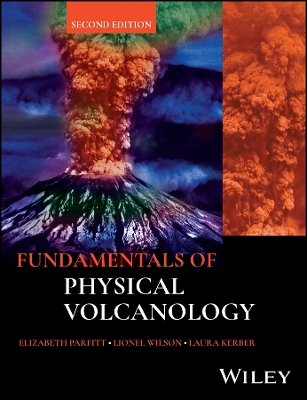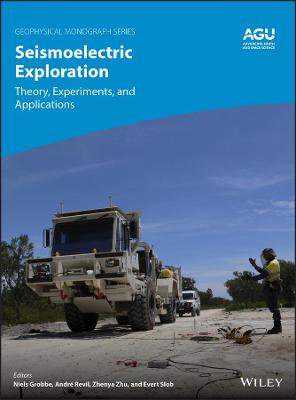Fundamentals of Physical Volcanology
 -10%
portes grátis
-10%
portes grátis
Fundamentals of Physical Volcanology
Kerber, Laura; Wilson, Lionel; Parfitt, Elisabeth
John Wiley & Sons Inc
04/2025
240
Mole
Inglês
9781119266419
Pré-lançamento - envio 15 a 20 dias após a sua edição
Descrição não disponível.
1. Volcanic systems Introduction Styles of volcanic eruptions Volcanic systems The structure and aims of this book Further reading / Questions to think about
2. Magma generation and segregation Introduction Rock-melting mechanisms Volcanism and plate tectonics Melting and melt segregation in the mantle Summary / Further reading / Questions to think about
3. Magma migration Introduction Diapiric rise of melt The change from diapir rise to dike formation Dike propagation Trapping of dikes Consequences of dike trapping Summary / Further reading / Questions to think about
4. Magma storage Introduction Evidence for magma storage within the crust Formation and growth of magma chambers Magma chambers and their impact on volcanic systems Summary / Further reading / Questions to think about
5. The role of volatiles Introduction Volatiles in magma The solubility of volatiles in magma Bubble nucleation Bubble growth Influence of volatiles on magma dynamics Magma fragmentation and the influence of volatiles on eruption styles Summary / Further reading / Questions to think about
6. Steady explosive eruptions Introduction Influence of gas bubbles prior to magma fragmentation Acceleration of the gas?magma mixture Controls on exit velocity Eruption plumes in steady eruptions Fallout of clasts from eruption plumes Unstable eruption columns Summary / Further reading / Questions to think about
7. Transient volcanic eruptions Introduction Magmatic explosions Transient eruptions involving external water Summary / Further reading / Questions to think about
8. Pyroclastic falls and pyroclastic density currents Introduction Fallout of clasts from eruption columns The application of eruption column models Pyroclastic density currents and their deposits Summary / Further reading / Questions to think about
9. Lava flows Introduction Origin of lava flows Types of lava flow Lava flow rheology Rheological control of lava flow geometry Lava flow motion Lengths of lava flows Surface textures of lava flows Effects of ground slope and lava viscosity Summary / Further reading / Questions to think about
10. Eruption styles, scales, and frequencies Introduction Chemical composition and styles of volcanic activity Chemical composition and effusive eruptions Chemical composition and explosive eruptions Summary of compositional controls on eruption character Magnitudes and frequencies of volcanic eruptions Elastic and inelastic eruptions and the contribution of "mush" Eruptions of exceptional magnitude Summary / Further reading / Questions to think about
11. Volcanic hazards and volcano monitoring Introduction Types of volcanic hazard Hazard assessment Monitoring volcanoes and short-term eruption prediction Hazard mitigation Summary / Further reading / Questions to think about
12. Volcanoes and climate Introduction Evidence for the impact of volcanic eruptions on climate Satellite monitoring of climate change after volcanic eruptions The effects of volcanic eruptions on climate Volcanoes and mass extinctions Summary / Further reading / Questions to think about
13. Volcanism on other planets Introduction Volcanically active bodies in the Solar System The effects of environmental conditions on volcanic processes The Moon Mars Venus Mercury Io Europa Differentiated asteroids Summary / Further reading / Questions to think about
Answers to questions Index
2. Magma generation and segregation Introduction Rock-melting mechanisms Volcanism and plate tectonics Melting and melt segregation in the mantle Summary / Further reading / Questions to think about
3. Magma migration Introduction Diapiric rise of melt The change from diapir rise to dike formation Dike propagation Trapping of dikes Consequences of dike trapping Summary / Further reading / Questions to think about
4. Magma storage Introduction Evidence for magma storage within the crust Formation and growth of magma chambers Magma chambers and their impact on volcanic systems Summary / Further reading / Questions to think about
5. The role of volatiles Introduction Volatiles in magma The solubility of volatiles in magma Bubble nucleation Bubble growth Influence of volatiles on magma dynamics Magma fragmentation and the influence of volatiles on eruption styles Summary / Further reading / Questions to think about
6. Steady explosive eruptions Introduction Influence of gas bubbles prior to magma fragmentation Acceleration of the gas?magma mixture Controls on exit velocity Eruption plumes in steady eruptions Fallout of clasts from eruption plumes Unstable eruption columns Summary / Further reading / Questions to think about
7. Transient volcanic eruptions Introduction Magmatic explosions Transient eruptions involving external water Summary / Further reading / Questions to think about
8. Pyroclastic falls and pyroclastic density currents Introduction Fallout of clasts from eruption columns The application of eruption column models Pyroclastic density currents and their deposits Summary / Further reading / Questions to think about
9. Lava flows Introduction Origin of lava flows Types of lava flow Lava flow rheology Rheological control of lava flow geometry Lava flow motion Lengths of lava flows Surface textures of lava flows Effects of ground slope and lava viscosity Summary / Further reading / Questions to think about
10. Eruption styles, scales, and frequencies Introduction Chemical composition and styles of volcanic activity Chemical composition and effusive eruptions Chemical composition and explosive eruptions Summary of compositional controls on eruption character Magnitudes and frequencies of volcanic eruptions Elastic and inelastic eruptions and the contribution of "mush" Eruptions of exceptional magnitude Summary / Further reading / Questions to think about
11. Volcanic hazards and volcano monitoring Introduction Types of volcanic hazard Hazard assessment Monitoring volcanoes and short-term eruption prediction Hazard mitigation Summary / Further reading / Questions to think about
12. Volcanoes and climate Introduction Evidence for the impact of volcanic eruptions on climate Satellite monitoring of climate change after volcanic eruptions The effects of volcanic eruptions on climate Volcanoes and mass extinctions Summary / Further reading / Questions to think about
13. Volcanism on other planets Introduction Volcanically active bodies in the Solar System The effects of environmental conditions on volcanic processes The Moon Mars Venus Mercury Io Europa Differentiated asteroids Summary / Further reading / Questions to think about
Answers to questions Index
Este título pertence ao(s) assunto(s) indicados(s). Para ver outros títulos clique no assunto desejado.
Undergraduate volcanology; eruption types; subsurface volcanic processes; eruption mechanisms; volcanic products; volcanoes and the environment; environmental effects of volcanoes; volcanology text; undergraduate volcanology text
1. Volcanic systems Introduction Styles of volcanic eruptions Volcanic systems The structure and aims of this book Further reading / Questions to think about
2. Magma generation and segregation Introduction Rock-melting mechanisms Volcanism and plate tectonics Melting and melt segregation in the mantle Summary / Further reading / Questions to think about
3. Magma migration Introduction Diapiric rise of melt The change from diapir rise to dike formation Dike propagation Trapping of dikes Consequences of dike trapping Summary / Further reading / Questions to think about
4. Magma storage Introduction Evidence for magma storage within the crust Formation and growth of magma chambers Magma chambers and their impact on volcanic systems Summary / Further reading / Questions to think about
5. The role of volatiles Introduction Volatiles in magma The solubility of volatiles in magma Bubble nucleation Bubble growth Influence of volatiles on magma dynamics Magma fragmentation and the influence of volatiles on eruption styles Summary / Further reading / Questions to think about
6. Steady explosive eruptions Introduction Influence of gas bubbles prior to magma fragmentation Acceleration of the gas?magma mixture Controls on exit velocity Eruption plumes in steady eruptions Fallout of clasts from eruption plumes Unstable eruption columns Summary / Further reading / Questions to think about
7. Transient volcanic eruptions Introduction Magmatic explosions Transient eruptions involving external water Summary / Further reading / Questions to think about
8. Pyroclastic falls and pyroclastic density currents Introduction Fallout of clasts from eruption columns The application of eruption column models Pyroclastic density currents and their deposits Summary / Further reading / Questions to think about
9. Lava flows Introduction Origin of lava flows Types of lava flow Lava flow rheology Rheological control of lava flow geometry Lava flow motion Lengths of lava flows Surface textures of lava flows Effects of ground slope and lava viscosity Summary / Further reading / Questions to think about
10. Eruption styles, scales, and frequencies Introduction Chemical composition and styles of volcanic activity Chemical composition and effusive eruptions Chemical composition and explosive eruptions Summary of compositional controls on eruption character Magnitudes and frequencies of volcanic eruptions Elastic and inelastic eruptions and the contribution of "mush" Eruptions of exceptional magnitude Summary / Further reading / Questions to think about
11. Volcanic hazards and volcano monitoring Introduction Types of volcanic hazard Hazard assessment Monitoring volcanoes and short-term eruption prediction Hazard mitigation Summary / Further reading / Questions to think about
12. Volcanoes and climate Introduction Evidence for the impact of volcanic eruptions on climate Satellite monitoring of climate change after volcanic eruptions The effects of volcanic eruptions on climate Volcanoes and mass extinctions Summary / Further reading / Questions to think about
13. Volcanism on other planets Introduction Volcanically active bodies in the Solar System The effects of environmental conditions on volcanic processes The Moon Mars Venus Mercury Io Europa Differentiated asteroids Summary / Further reading / Questions to think about
Answers to questions Index
2. Magma generation and segregation Introduction Rock-melting mechanisms Volcanism and plate tectonics Melting and melt segregation in the mantle Summary / Further reading / Questions to think about
3. Magma migration Introduction Diapiric rise of melt The change from diapir rise to dike formation Dike propagation Trapping of dikes Consequences of dike trapping Summary / Further reading / Questions to think about
4. Magma storage Introduction Evidence for magma storage within the crust Formation and growth of magma chambers Magma chambers and their impact on volcanic systems Summary / Further reading / Questions to think about
5. The role of volatiles Introduction Volatiles in magma The solubility of volatiles in magma Bubble nucleation Bubble growth Influence of volatiles on magma dynamics Magma fragmentation and the influence of volatiles on eruption styles Summary / Further reading / Questions to think about
6. Steady explosive eruptions Introduction Influence of gas bubbles prior to magma fragmentation Acceleration of the gas?magma mixture Controls on exit velocity Eruption plumes in steady eruptions Fallout of clasts from eruption plumes Unstable eruption columns Summary / Further reading / Questions to think about
7. Transient volcanic eruptions Introduction Magmatic explosions Transient eruptions involving external water Summary / Further reading / Questions to think about
8. Pyroclastic falls and pyroclastic density currents Introduction Fallout of clasts from eruption columns The application of eruption column models Pyroclastic density currents and their deposits Summary / Further reading / Questions to think about
9. Lava flows Introduction Origin of lava flows Types of lava flow Lava flow rheology Rheological control of lava flow geometry Lava flow motion Lengths of lava flows Surface textures of lava flows Effects of ground slope and lava viscosity Summary / Further reading / Questions to think about
10. Eruption styles, scales, and frequencies Introduction Chemical composition and styles of volcanic activity Chemical composition and effusive eruptions Chemical composition and explosive eruptions Summary of compositional controls on eruption character Magnitudes and frequencies of volcanic eruptions Elastic and inelastic eruptions and the contribution of "mush" Eruptions of exceptional magnitude Summary / Further reading / Questions to think about
11. Volcanic hazards and volcano monitoring Introduction Types of volcanic hazard Hazard assessment Monitoring volcanoes and short-term eruption prediction Hazard mitigation Summary / Further reading / Questions to think about
12. Volcanoes and climate Introduction Evidence for the impact of volcanic eruptions on climate Satellite monitoring of climate change after volcanic eruptions The effects of volcanic eruptions on climate Volcanoes and mass extinctions Summary / Further reading / Questions to think about
13. Volcanism on other planets Introduction Volcanically active bodies in the Solar System The effects of environmental conditions on volcanic processes The Moon Mars Venus Mercury Io Europa Differentiated asteroids Summary / Further reading / Questions to think about
Answers to questions Index
Este título pertence ao(s) assunto(s) indicados(s). Para ver outros títulos clique no assunto desejado.





